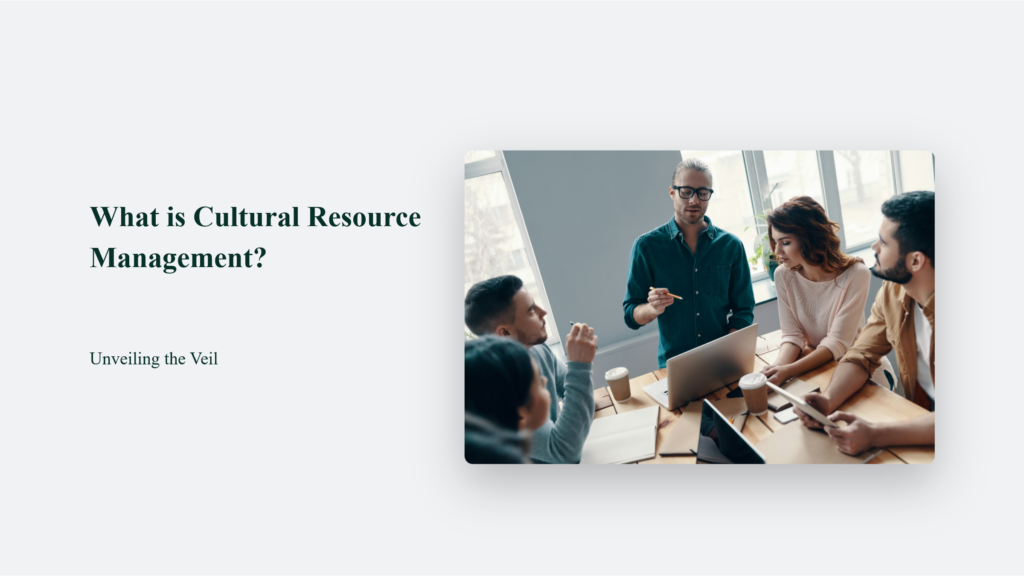

What is Cultural Resource Management? Unveiling the Veil

As Seen On
In the realm of heritage and history, a crucial yet often overlooked practice safeguards the narratives and artifacts of our past. This practice, known as Cultural Resource Management (CRM), is a beacon of balance, harmoniously integrating the relentless march of progress with the sacred duty of preserving cultural heritage. So, let’s find out more about what is cultural resource management.

Key Takeaways
- Cultural Resource Management is Essential for Preservation and Progress: CRM ensures that we do not erase our past as we build our future.
- CRM is Interdisciplinary: It encompasses a wide range of disciplines to safeguard cultural heritage.
- Economic and Social Value: CRM highlights the economic and social importance of preserving cultural assets.
- Public Engagement and Participation: A critical aspect of CRM involves the community and stakeholders in the preservation process.
What is Cultural Resource Management?
At its core, Cultural Resource Management is the meticulous process through which we manage, protect, and present cultural resources. These resources are not just relics of the past; they are the stories, artifacts, landscapes, and structures that connect us to our history and identity. CRM encompasses various disciplines, including archaeology, anthropology, historic archaeology, architectural history, and the study of cultural landscapes and industrial heritage. It is about ensuring that as our communities evolve and our landscapes change, we maintain the cultural legacies that define us.
The Duality of Progress and Preservation:
Guardian of Cultural Heritage
- What It Means: CRM acts as a protective steward for cultural resources amid development projects and economic growth.
- Why It Matters: This role is crucial for ensuring that the insights and knowledge embedded in our cultural heritage are preserved for future generations.
Facilitator of Sustainable Development
- What It Means: CRM professionals ensure that new infrastructure projects and residential developments are pursued with a mindfulness towards cultural heritage.
- Why It Matters: By integrating preservation efforts into development projects, CRM helps achieve a sustainable balance that respects past and future needs.
Promoter of Public Engagement
- What It Means: A significant part of CRM involves sharing findings with the public and involving community stakeholders in the preservation process.
- Why It Matters: This engagement ensures that the community values and understands its cultural heritage, fostering a collective responsibility towards its preservation.
Advocate for Informed Decision-Making
- What It Means: CRM professionals work to ensure that decisions around development and preservation consider the significance of cultural resources.
- Why It Matters: Through informed decision-making, CRM helps navigate the complexities of progress and preservation, ensuring that cultural heritage is not sacrificed for development.
Bridge Between Past and Present
- What It Means: By preserving cultural resources, CRM maintains a link between the past and the present, ensuring that historical narratives and identities are not lost.
- Why It Matters: This connection enriches our understanding of history and culture, providing a foundation for identity and continuity.
Enabler of Economic Benefits
- What It Means: Preservation efforts through CRM can also lead to economic benefits, such as tourism, education, and community development.
- Why It Matters: These benefits highlight the tangible value of cultural heritage, making the case for its preservation even stronger.
Catalyst for Education and Learning
- What It Means: CRM provides opportunities for educational programs, research, and learning about our cultural heritage.
- Why It Matters: Education and awareness are key to fostering appreciation and support for cultural preservation efforts.
Architect of the Future’s Legacy
- What It Means: By carefully managing cultural resources, CRM professionals are essentially designing the historical legacy of our current era.
- Why It Matters: This responsibility underscores the importance of CRM in ensuring that future generations inherit a rich, well-preserved cultural heritage.
Cultural Resource Management embodies a crucial balance between embracing progress and safeguarding our cultural legacy. As we forge ahead into the future, CRM will continue to play an essential role in ensuring that development and preservation go hand in hand, crafting a legacy that honours our past while embracing the potential of our future.

Cultural Resource Management: Beyond Archaeology
Cultural Resource Management (CRM) is an essential field beyond the common perception of being solely about archaeology. Its interdisciplinary nature encompasses a broad spectrum of practices to preserve cultural heritage and integrate it with modern-day developments. Here, we dive into the various dimensions of CRM, showcasing its depth and breadth.
Historical Records Research
CRM involves meticulously researching historical records to uncover the stories and data embedded within documents, manuscripts, and archival materials. This aspect of CRM aims to contextualise cultural sites and artifacts within their historical narratives, providing a deeper understanding of their significance.
Architectural History
The study and preservation of architectural heritage are pivotal components of CRM. This discipline focuses on understanding the historical, aesthetic, and technological significance of buildings, structures, and landscapes. By documenting and analysing architectural styles, construction techniques, and historical contexts, CRM professionals work to preserve the physical manifestations of our cultural identity.
Cultural Landscapes Recognition
Cultural landscapes—representing the combined works of nature and humans—are a crucial focus of CRM. This involves identifying, documenting, and managing landscapes that have historical, cultural, aesthetic, or ecological value. CRM recognises the importance of these landscapes in telling the stories of communities and civilisations and their interactions with the environment over time.
Industrial Heritage Appreciation
CRM also extends to the appreciation and preservation of industrial heritage, which includes the sites, structures, and complexes associated with industrial processes, technological advancements, and economic development. This facet of CRM aims to safeguard the legacy of the industrial age, recognising its impact on society and its contribution to the cultural landscape.
Anthropological and Ethnographic Studies
Another critical aspect of CRM is engaging with living communities to understand their traditions, practices, and connections to cultural sites and artifacts. Anthropological and ethnographic studies help preserve intangible cultural heritage, such as folklore, rituals, and language, ensuring that the knowledge and practices of diverse cultures are recognised and maintained.
Public Involvement and Education
An integral part of CRM is engaging the public through education and involvement in the preservation process. CRM aims to build support for preservation efforts and encourage active participation in safeguarding cultural heritage by fostering a deeper understanding and appreciation of cultural resources in the community.
Legislation and Policy Development
CRM professionals develop and implement legislation and policies to protect cultural resources. They work with governments, organisations, and communities to ensure that laws and regulations support cultural heritage identification, preservation, and management.
Sustainable Development and Planning
CRM professionals are critical in incorporating cultural heritage considerations into urban and rural development plans. CRM professionals aim to ensure that growth and progress do not come at the expense of cultural heritage by advocating for the integration of preservation principles in development projects.
Cultural Resource Management guards our collective memory and cultural identity through these diverse practices. It bridges the past and present, ensuring that our cultural heritage is preserved for future generations and appreciated and integrated into the fabric of modern society.
The Impact and Importance of CRM
Cultural Resource Management has evolved significantly, driven by a growing recognition of cultural assets’ economic, social, and intrinsic value. The policies governing CRM have matured, reflecting a sophisticated understanding of the need to balance economic development with the preservation of cultural heritage. CRM highlights the controversial nature of exploiting cultural resources, whether through the antiquities market or the commercialisation of traditional knowledge, and emphasises the importance of traditional crafts, dances, music, and designs as cultural expressions and vital economic assets.
The Bottom Line:
In the quest for modernity, let us not forget the essence of our past. Cultural Resource Management is a testament to our dedication to preserving the rich tapestry of human history and culture. As we look to the future, may we always remember the value of what came before, ensuring that our cultural heritage is remembered and, cherished and protected for generations to come.
Frequently Asked Questions:
Who practices Cultural Resource Management?
Professionals across various fields, including archaeology, anthropology, historic archaeology, architectural history, and more, engage in CRM.
Why is CRM important?
CRM is vital for ensuring that development and economic growth do not come at the cost of losing our cultural heritage.
Can cultural resources be both preserved and utilized?
Yes, through CRM, cultural resources can be both preserved for future generations and used to enrich our understanding of history and culture.
Konger
Up until working with Casey, we had only had poor to mediocre experiences outsourcing work to agencies. Casey & the team at CJ&CO are the exception to the rule.
Communication was beyond great, his understanding of our vision was phenomenal, and instead of needing babysitting like the other agencies we worked with, he was not only completely dependable but also gave us sound suggestions on how to get better results, at the risk of us not needing him for the initial job we requested (absolute gem).
This has truly been the first time we worked with someone outside of our business that quickly grasped our vision, and that I could completely forget about and would still deliver above expectations.
I honestly can't wait to work in many more projects together!
Disclaimer
*The information this blog provides is for general informational purposes only and is not intended as financial or professional advice. The information may not reflect current developments and may be changed or updated without notice. Any opinions expressed on this blog are the author’s own and do not necessarily reflect the views of the author’s employer or any other organization. You should not act or rely on any information contained in this blog without first seeking the advice of a professional. No representation or warranty, express or implied, is made as to the accuracy or completeness of the information contained in this blog. The author and affiliated parties assume no liability for any errors or omissions.

